Analyzing the Charging Flexibility Potential of Different Electric Vehicle Fleets Using Real-World Charging Data
Abstract
:1. Introduction
2. Literature Review
2.1. Electric Vehicle Charging Data Analysis
2.2. Charging Flexibility
3. Input Data
3.1. Data Preparation
3.1.1. Disaggregation
- Duration must be greater than or equal to five minutes ( min).
- Charging rate must be greater than zero Watts ( 0 ).
- Charged energy must be greater than or equal to 100 .
3.1.2. Discretization
3.1.3. Addition
3.1.4. Aggregation
3.2. Data Set and Characteristics
3.2.1. Data Set
- (a)
- Office site: The fleet consists of fifteen battery electric vehicless (BEVs), including five company pool vehicles and ten private-owned vehicles of employees. The office site is located in an urban region. An urban depot is where mainly company and employee vehicles are charged. Eight charging points are available.
- (b)
- Logistics site: The EV fleet consists of twelve delivery vans (Mercedes e-Vito). Twelve charging points are available.
- (c)
- Agency site: The vehicle depot of the public agency solely consists of twelve company vehicles of different types. Twelve charging points are available.
3.2.2. Data Selection and Characteristics
4. Analysis of the Charging Flexibility
4.1. Idle Time
4.2. Time-Shift-Flexibility
- Fixed charging rate:
- Maximum measured charging rate of the associated charging event:
- Average charging power of the associated charging process: .
4.3. FlexBars
5. Conclusions
Author Contributions
Funding
Institutional Review Board Statement
Informed Consent Statement
Acknowledgments
Conflicts of Interest
Abbreviations
| RES | renewable energy sources |
| EV | electric vehicle |
| BEV | battery electric vehicles |
References
- Edenhofer, O.; Pichs-Madruga, R.; Sokona, Y.; Farahani, E.; Kadner, S.; Seyboth, K.; Adler, A.; Baum, I.; Brunner, S.; Eickemeier, P.; et al. (Eds.) Mitigation of Climate Change. Contribution of Working Group III to the Fifth Assessment Report of the Intergovernmental Panel on Climate Change; Cambridge University Press: Cambridge, UK, 2014. [Google Scholar]
- Bundesnetzagentur. Monitoring Report 2019—Key Findings and Summary; Bundesnetzagentur: Bonn, Germany, 2019. [Google Scholar]
- The Mobility House. Charge Pilot—Charging and Energy Management. 2021. Available online: https://www.mobilityhouse.com/int_en/charging-and-energy-management (accessed on 31 May 2021).
- Schlund, J.; Pruckner, M.; German, R. FlexAbility-Modeling and Maximizing the Bidirectional Flexibility Availability of Unidirectional Charging of Large Pools of Electric Vehicles. In Proceedings of the Eleventh ACM International Conference on Future Energy Systems, Melbourne, Australia, 22–26 June 2020; pp. 121–132. [Google Scholar]
- Gerritsma, M.K.; AlSkaif, T.A.; Fidder, H.A.; van Sark, W.G. Flexibility of Electric Vehicle Demand: Analysis of Measured Charging Data and Simulation for the Future. World Electr. Veh. J. 2019, 10, 14. [Google Scholar] [CrossRef] [Green Version]
- Strobel, L.; Schlund, J.; Brandmeier, V.; Schreiber, M.; Pruckner, M. Smart Charging and Renewable Grid Integration—A Case Study Based on Real-Data of the Island of Porto Santo. In Proceedings of the Sustainable Energy for Smart Cities: Second EAI International Conference, SESC 2020, Viana do Castelo, Portugal, 4 December 2020; Springer: Berlin/Heidelberg, Germany, 2021; pp. 200–215. [Google Scholar]
- Lee, Z.J.; Li, T.; Low, S.H. ACN-Data: Analysis and Applications of an Open EV Charging Dataset. In Proceedings of the e-Energy 2019: Tenth ACM International Conference on Future Energy Systems, Phoenix, AZ, USA, 25–28 June 2019; Association for Computing Machinery: New York, NY, USA, 2019; pp. 139–149. [Google Scholar]
- Khan, S.; Brandherm, B.; Swamy, A. Electric Vehicle User Behavior Prediction using Learning-based Approaches. In Proceedings of the 2020 IEEE Electric Power and Energy Conference (EPEC), Edmonton, AB, Canada, 9–10 November 2020; IEEE: Piscataway, NJ, USA, 2020; pp. 1–5. [Google Scholar]
- Venegas, F.G.; Petit, M.; Perez, Y. Active integration of electric vehicles into distribution grids: Barriers and frameworks for flexibility services. Renew. Sustain. Energy Rev. 2021, 145, 111060. [Google Scholar] [CrossRef]
- Flammini, M.G.; Prettico, G.; Julea, A.; Fulli, G.; Mazza, A.; Chicco, G. Statistical characterisation of the real transaction data gathered from electric vehicle charging stations. Electr. Power Syst. Res. 2019, 166, 136–150. [Google Scholar] [CrossRef]
- Develder, C.; Sadeghianpourhamami, N.; Strobbe, M.; Refa, N. Quantifying flexibility in EV charging as DR potential: Analysis of two real-world data sets. In Proceedings of the 2016 IEEE International Conference on Smart Grid Communications (SmartGridComm), Sydney, Australia, 6–9 November 2016; pp. 600–605. [Google Scholar]
- Sadeghianpourhamami, N.; Refa, N.; Strobbe, M.; Develder, C. Quantitive analysis of electric vehicle flexibility: A data-driven approach. Int. J. Electr. Power Energy Syst. 2018, 95, 451–462. [Google Scholar] [CrossRef] [Green Version]
- Lahariya, M.; Benoit, D.; Develder, C. Defining a Synthetic Data Generator for Realistic Electric Vehicle Charging Sessions. In Proceedings of the e-Energy ’20: Eleventh ACM International Conference on Future Energy Systems, Melbourne, Australia, 22–26 June 2020; Association for Computing Machinery: New York, NY, USA, 2020; pp. 406–407. [Google Scholar]
- Xydas, E.; Marmaras, C.; Cipcigan, L.M.; Jenkins, N.; Carroll, S.; Barker, M. A data-driven approach for characterising the charging demand of electric vehicles: A UK case study. Appl. Energy 2016, 162, 763–771. [Google Scholar] [CrossRef] [Green Version]
- Sørensen, R.; Lindberg, K.; Sartori, I.; Andresen, I. Analysis of residential EV energy flexibility potential based on real-world charging reports and smart meter data. Energy Build. 2021, 241, 110923. [Google Scholar] [CrossRef]
- Sørensen, Å.L.; Lindberg, K.B.; Sartori, I.; Andresen, I. Residential electric vehicle charging datasets from apartment buildings. Data Brief 2021, 36, 107105. [Google Scholar] [CrossRef] [PubMed]
- Rauma, K.; Funke, A.; Simolin, T.; Järventausta, P.; Rehtanz, C. Electric Vehicles as a Flexibility Provider: Optimal Charging Schedules to Improve the Quality of Charging Service. Electricity 2021, 2, 14. [Google Scholar] [CrossRef]
- Šikšnys, L.; Pedersen, T.B. Dependency-based FlexOffers: Scalable Management of Flexible Loads with Dependencies. In Proceedings of the e-Energy ’16: Seventh International Conference on Future Energy Systems, Waterloo, ON, Canada, 21–24 June 2016; ACM: New York, NY, USA, 2016; pp. 11:1–11:13. [Google Scholar] [CrossRef]
- Neupane, B.; Šikšnys, L.; Pedersen, T.B. Generation and Evaluation of Flex-Offers from Flexible Electrical Devices. In Proceedings of the e-Energy ’17: Eighth International Conference on Future Energy Systems, Hong Kong, China, 16–19 May 2017; ACM: New York, NY, USA, 2017; pp. 143–156. [Google Scholar] [CrossRef]
- Boehm, M.; Dannecker, L.; Doms, A.; Dovgan, E.; Filipic, B.; Fischer, U.; Lehner, W.; Pedersen, T.; Pitarch, Y.; Siksnys, L.; et al. Data management in the MIRABEL smart grid system. In Proceedings of the ICDT ’12: 15th International Conference on Database Theory, Berlin, Germany, 30 March 2012. [Google Scholar] [CrossRef] [Green Version]
- Pedersen, T.B.; Šikšnys, L.; Neupane, B. Modeling and Managing Energy Flexibility Using FlexOffers. In Proceedings of the 2018 IEEE International Conference on Communications, Control, and Computing Technologies for Smart Grids (SmartGridComm), Aalborg, Denmark, 29–31 October 2018; pp. 1–7. [Google Scholar] [CrossRef] [Green Version]
- Li, T.; Low, S.H.; Wierman, A. Real-Time Flexibility Feedback for Closed-Loop Aggregator and System Operator Coordination. In Proceedings of the Eleventh ACM International Conference on Future Energy Systems (e-Energy ’20), Melbourne, Australia, 22–26 June 2020; Association for Computing Machinery: New York, NY, USA, 2020; pp. 279–292. [Google Scholar]
- Sundstrom, O.; Binding, C. Flexible Charging Optimization for Electric Vehicles Considering Distribution Grid Constraints. IEEE Trans. Smart Grid 2012, 3, 26–37. [Google Scholar] [CrossRef]
- Pertl, M.; Carducci, F.; Tabone, M.; Marinelli, M.; Kiliccote, S.; Kara, E.C. An Equivalent Time-Variant Storage Model to Harness EV Flexibility: Forecast and Aggregation. IEEE Trans. Ind. Inform. 2019, 15, 1899–1910. [Google Scholar] [CrossRef] [Green Version]
- Sperstad, I.B.; Degefa, M.Z.; Kjølle, G. The impact of flexible resources in distribution systems on the security of electricity supply: A literature review. Electr. Power Syst. Res. 2020, 188. [Google Scholar] [CrossRef]
- Amini, S.; Pasqualetti, F.; Mohsenian-Rad, H. Dynamic Load Altering Attacks Against Power System Stability: Attack Models and Protection Schemes. IEEE Trans. Smart Grid 2018, 9, 2862–2872. [Google Scholar] [CrossRef]
- Spitzer, M.; Schlund, J.; Apostolaki-Iosifidou, E.; Pruckner, M. Optimized integration of electric vehicles in low voltage distribution grids. Energies 2019, 12, 4059. [Google Scholar] [CrossRef] [Green Version]
- Bons, P.C.; Buatois, A.; Schuring, F.; Geerts, F.; van den Hoed, R. Flexible Charging of Electric Vehicles: Results of a Large-Scale Smart Charging Demonstration. World Electr. Veh. J. 2021, 12, 82. [Google Scholar] [CrossRef]
- Gesetz über die Elektrizitäts- und Gasversorgung: § 14a Steuerbare Verbrauchseinrichtungen in Niederspannung; Verordnungsermächtigung: Energiewirtschaftsgesetz—EnWG, 22.11.2020 (BGBl. I S. 2464). Available online: https://www.gesetze-im-internet.de/enwg_2005/__14a.html (accessed on 25 June 2021).

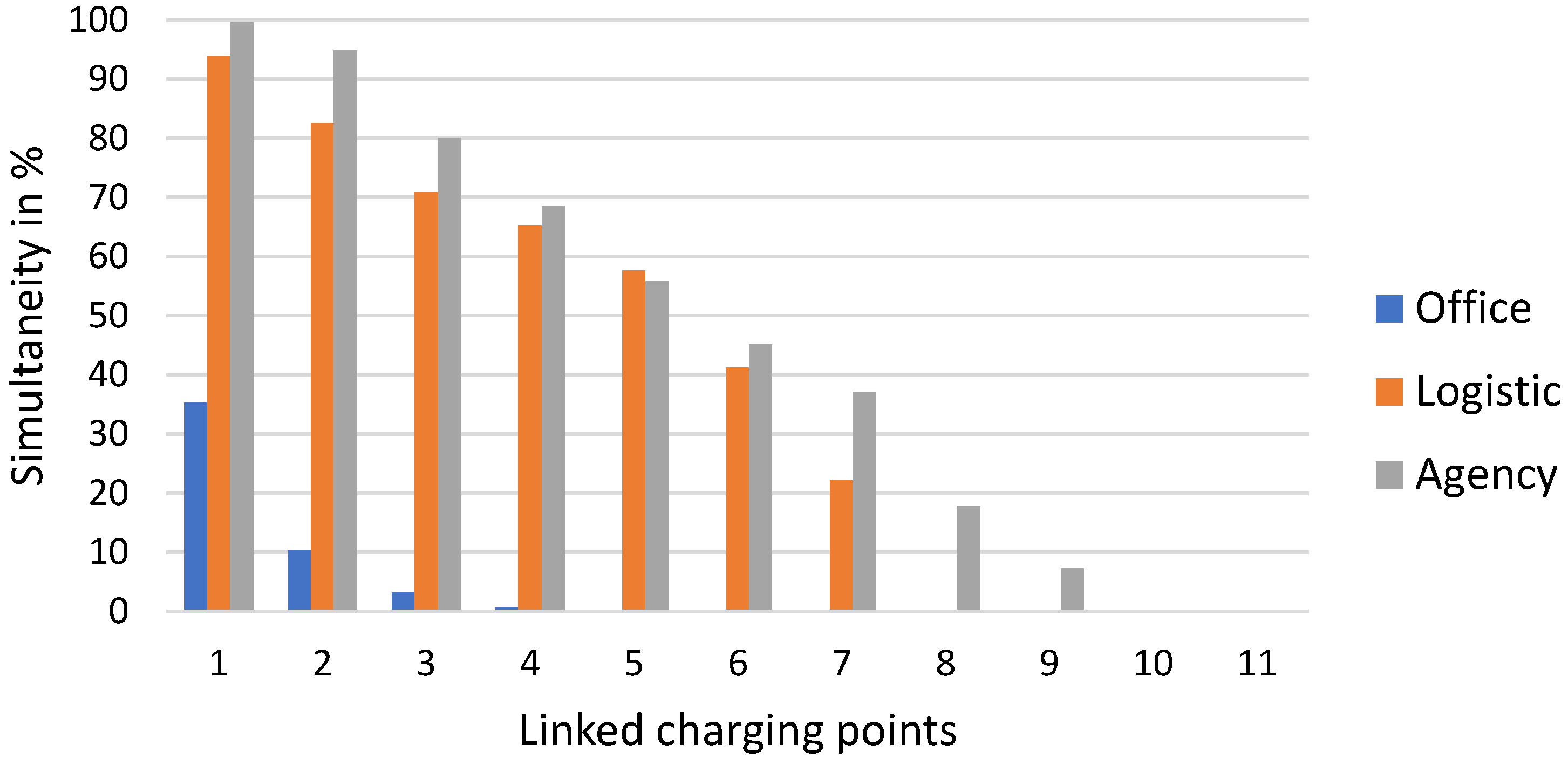

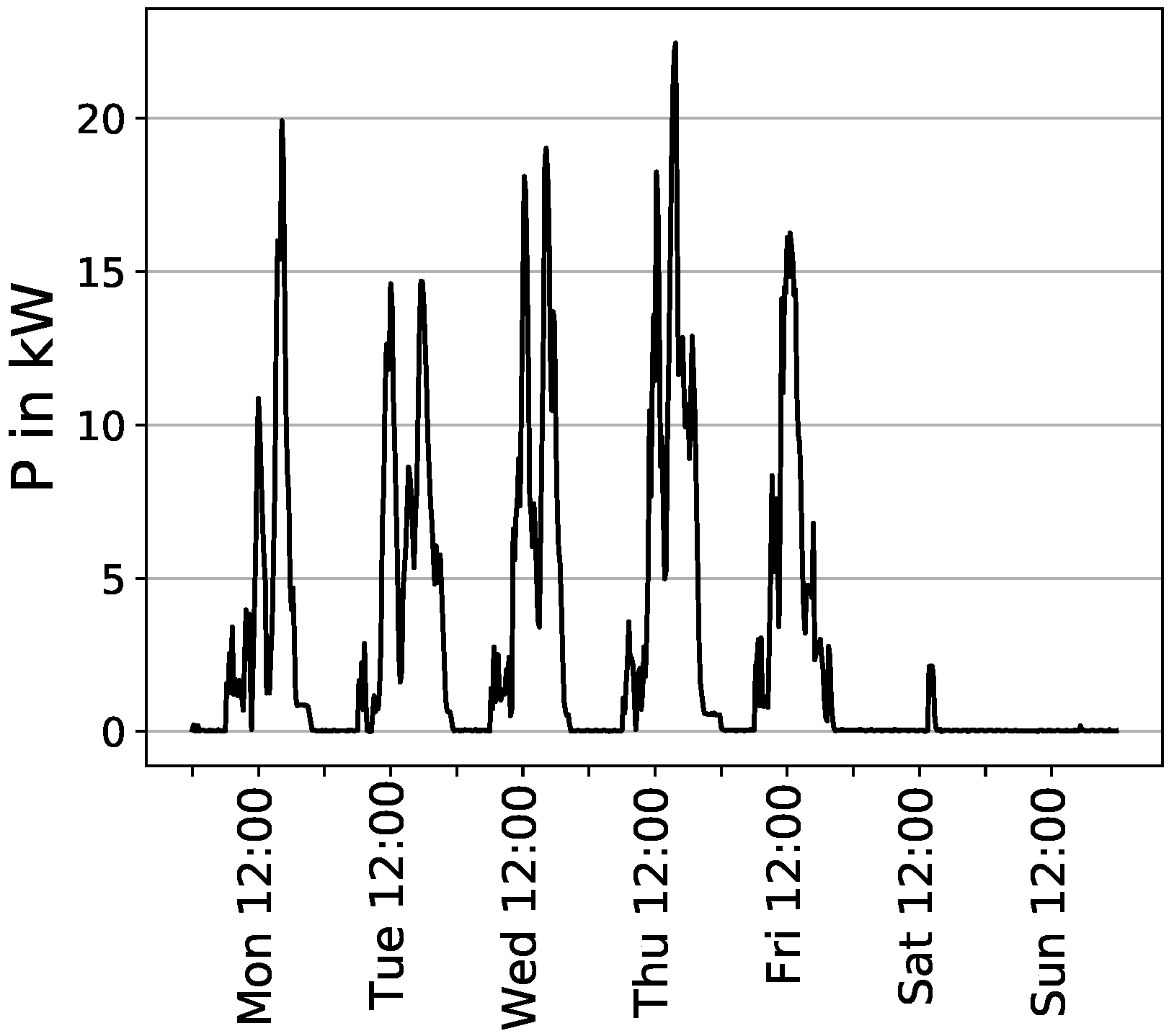
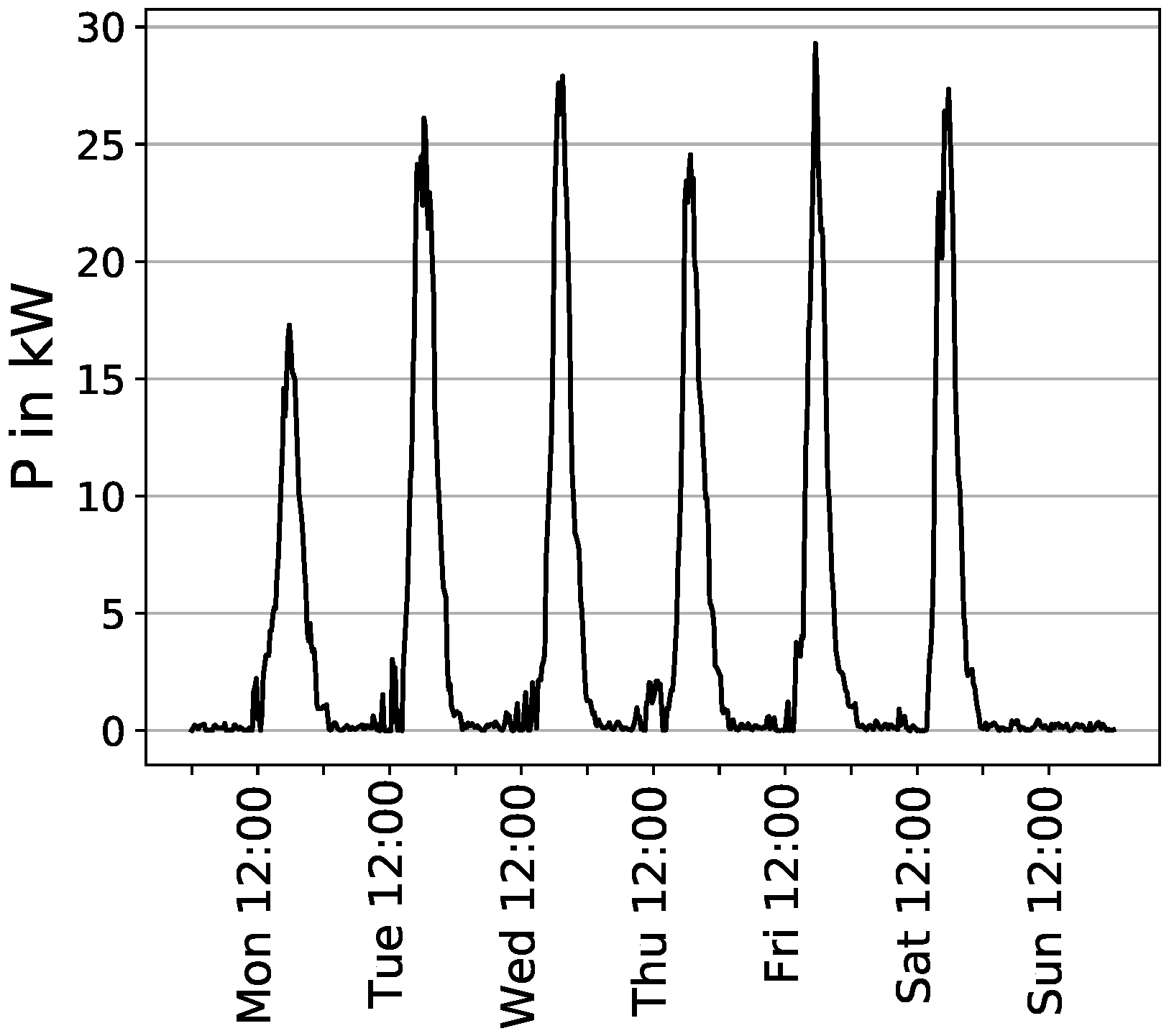
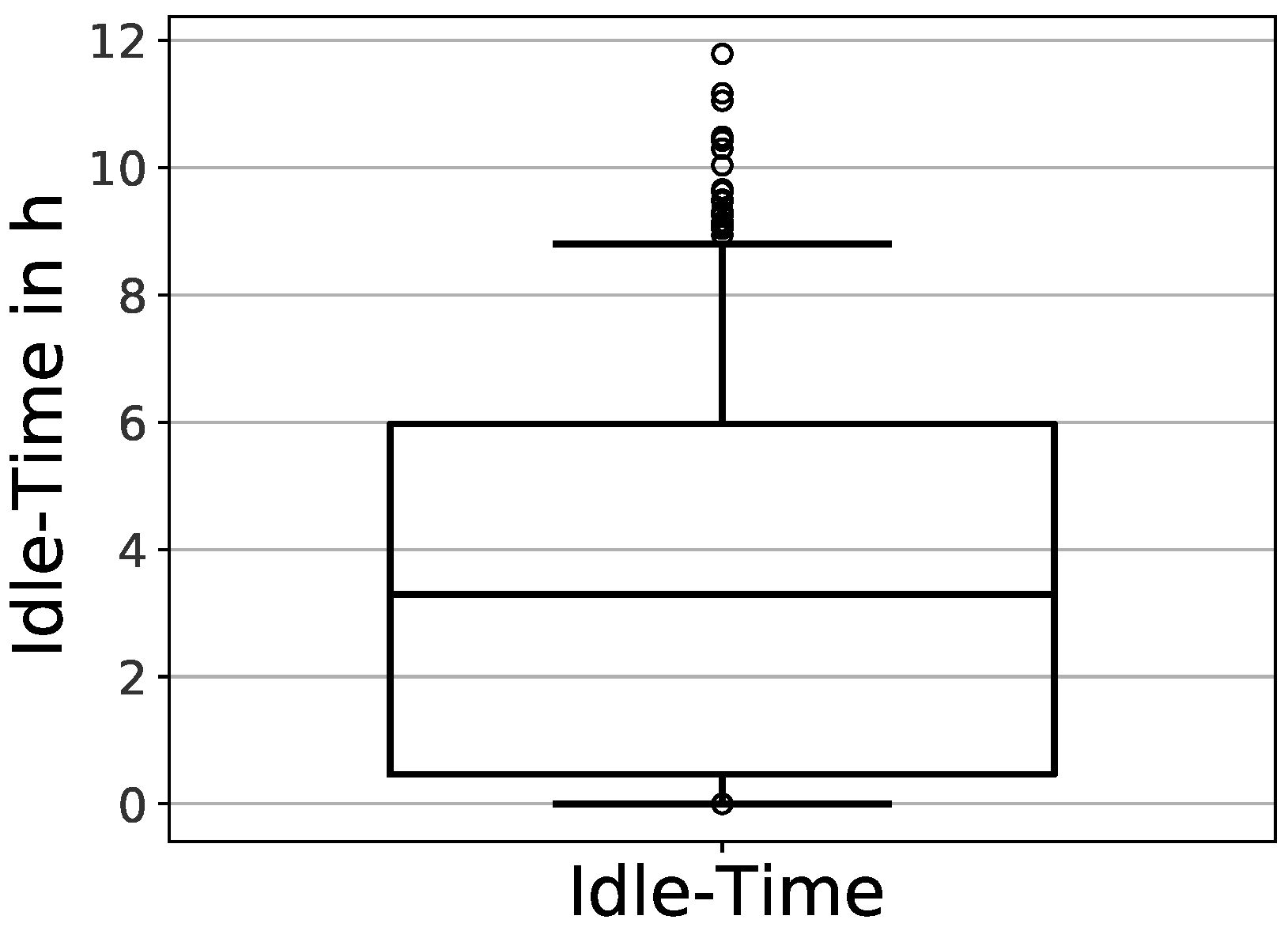
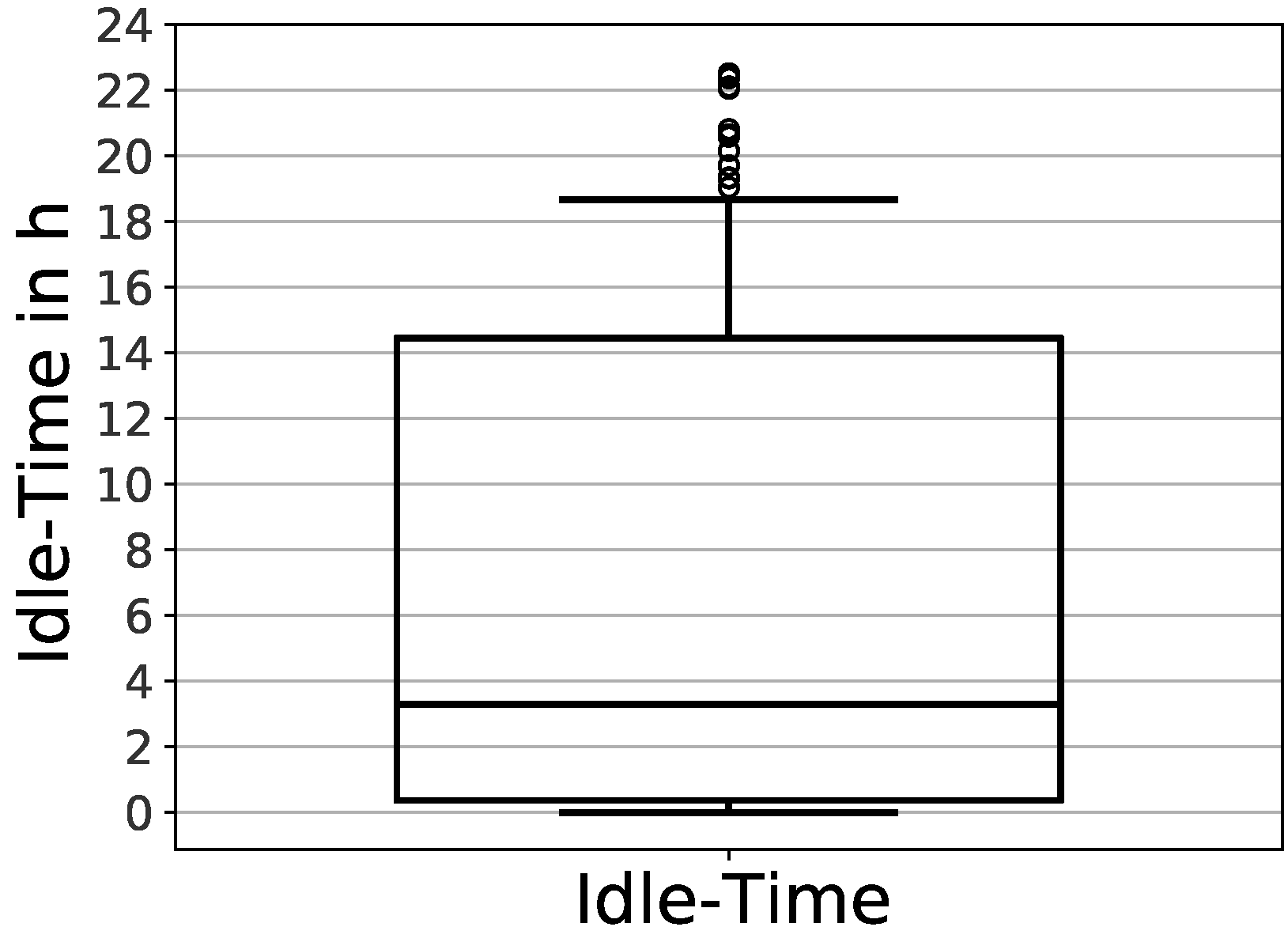
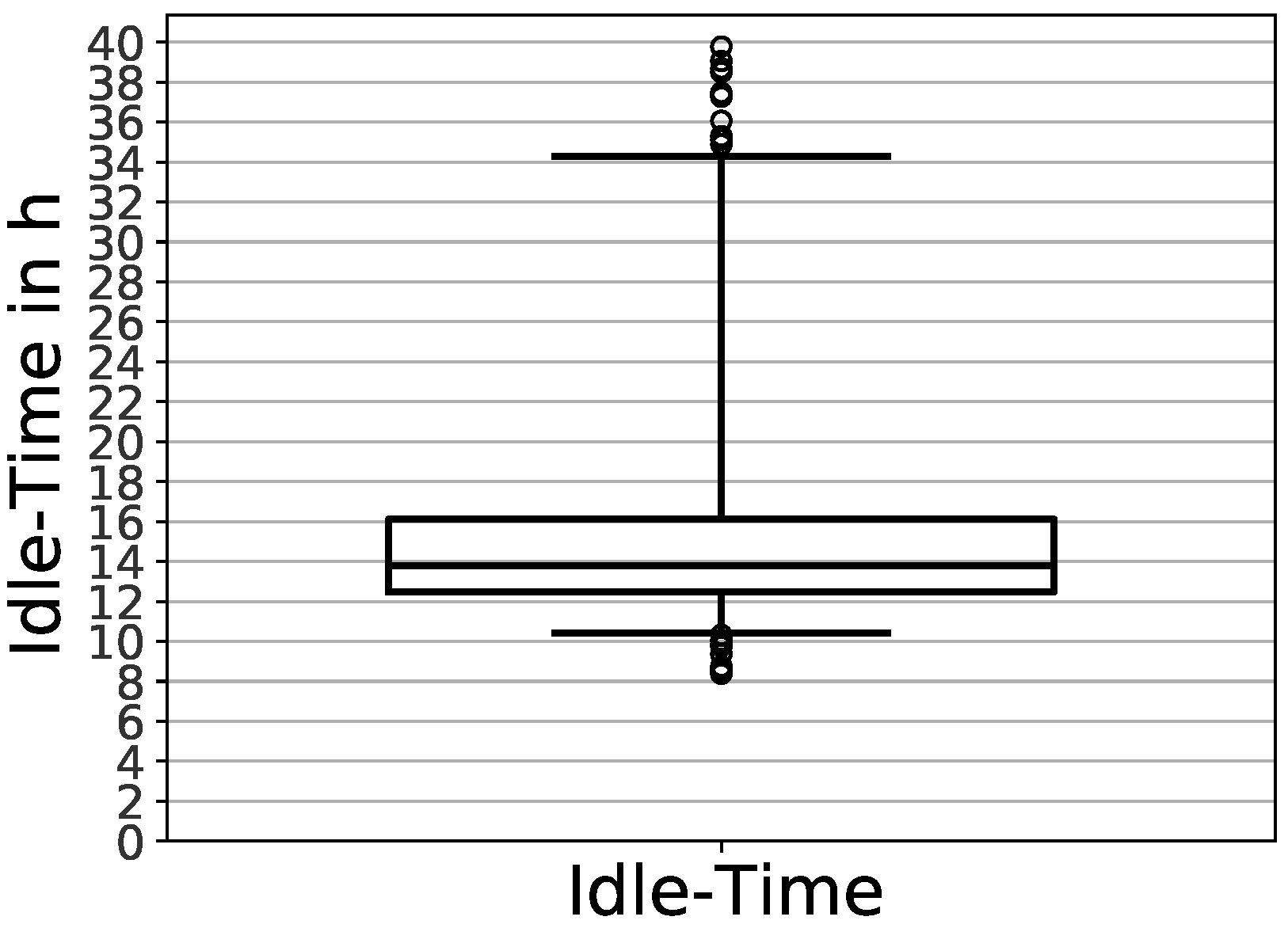
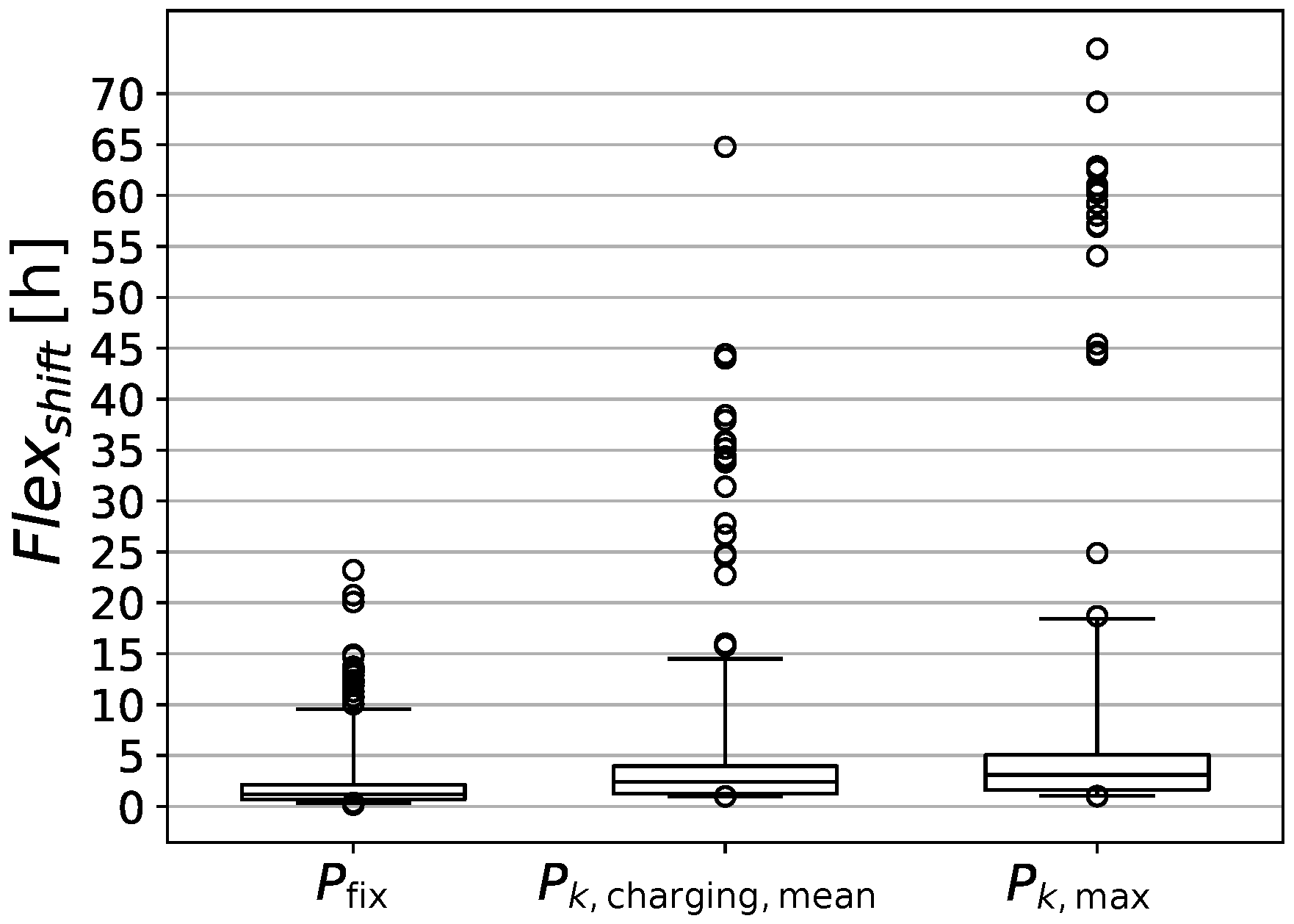
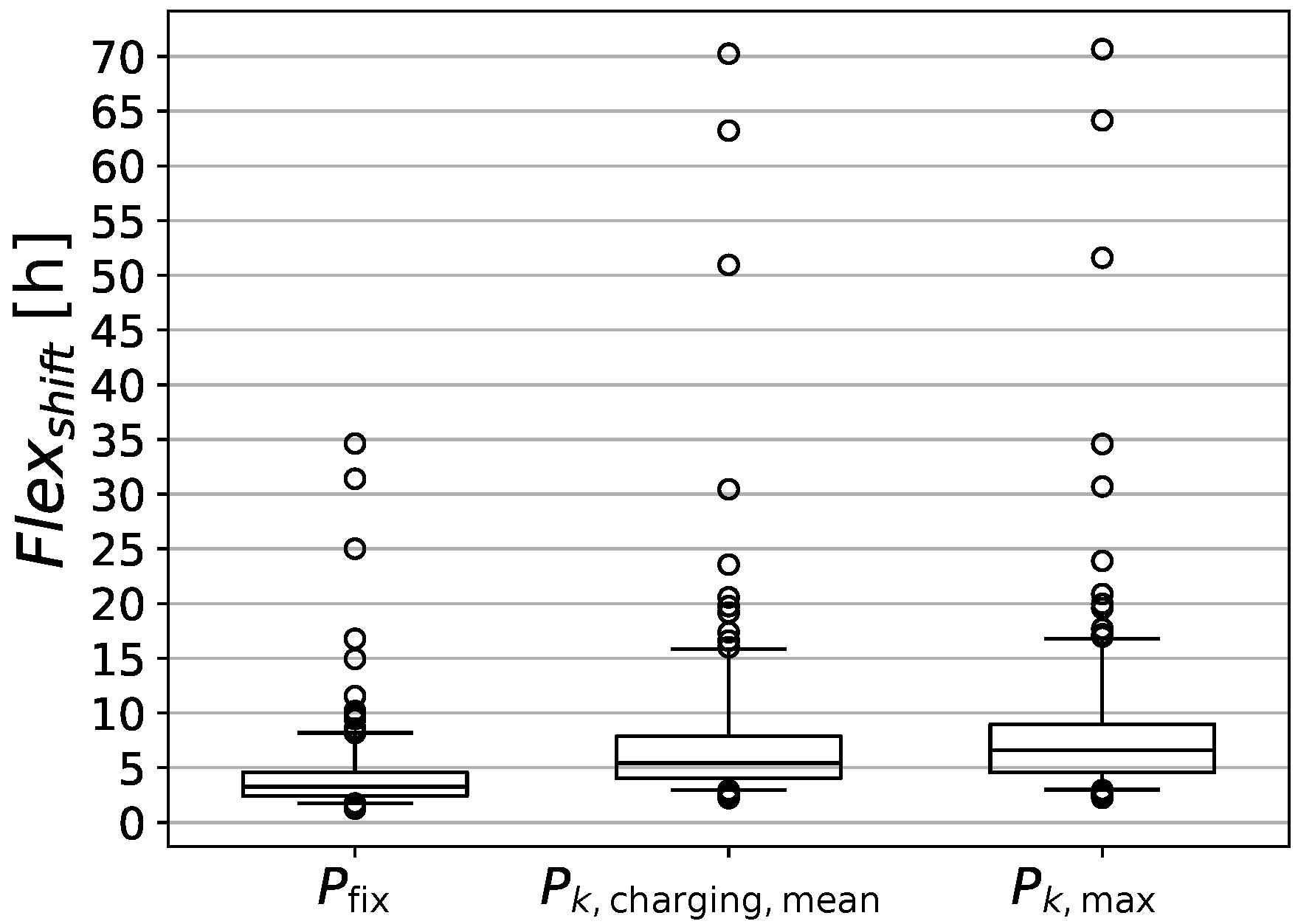
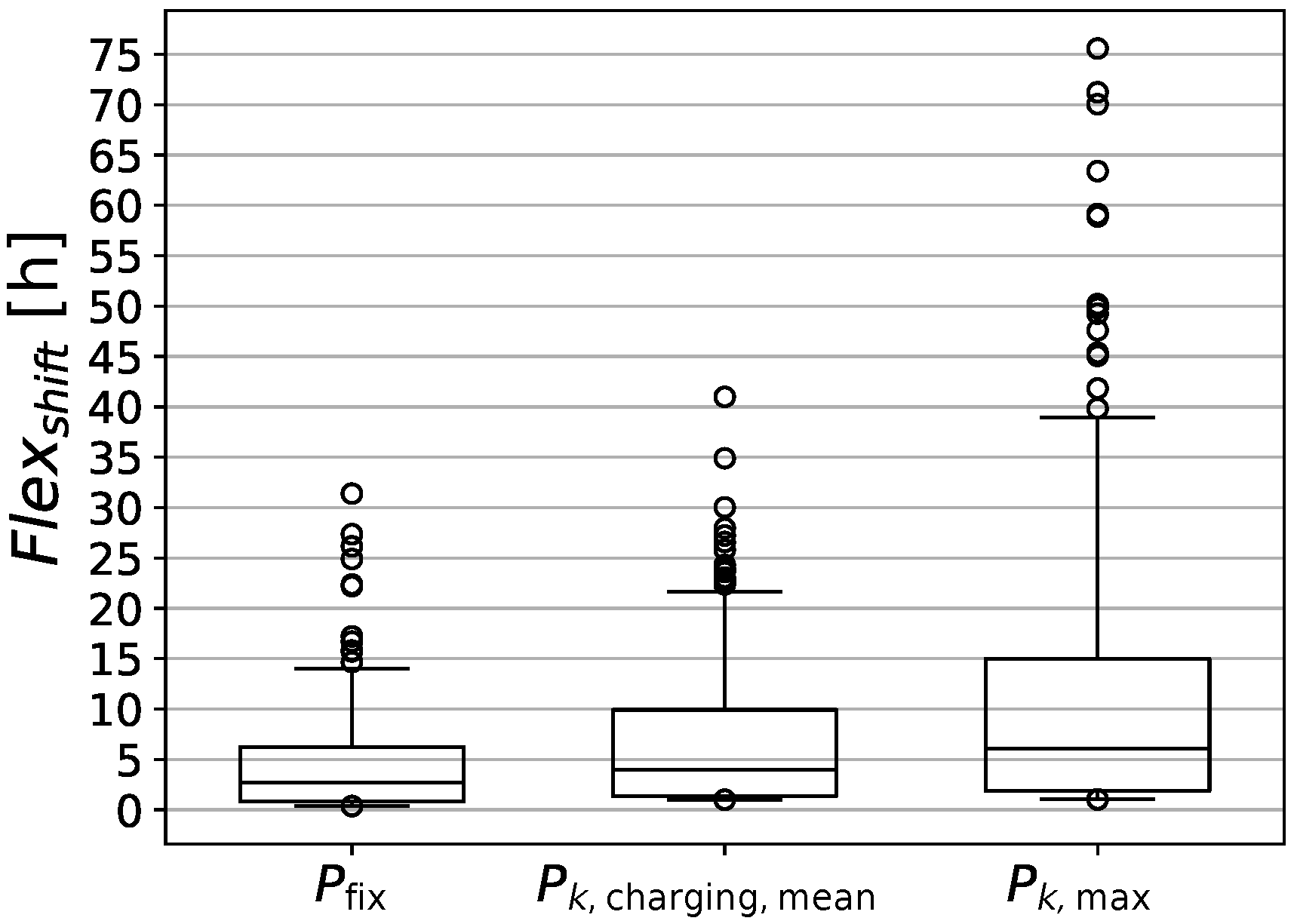


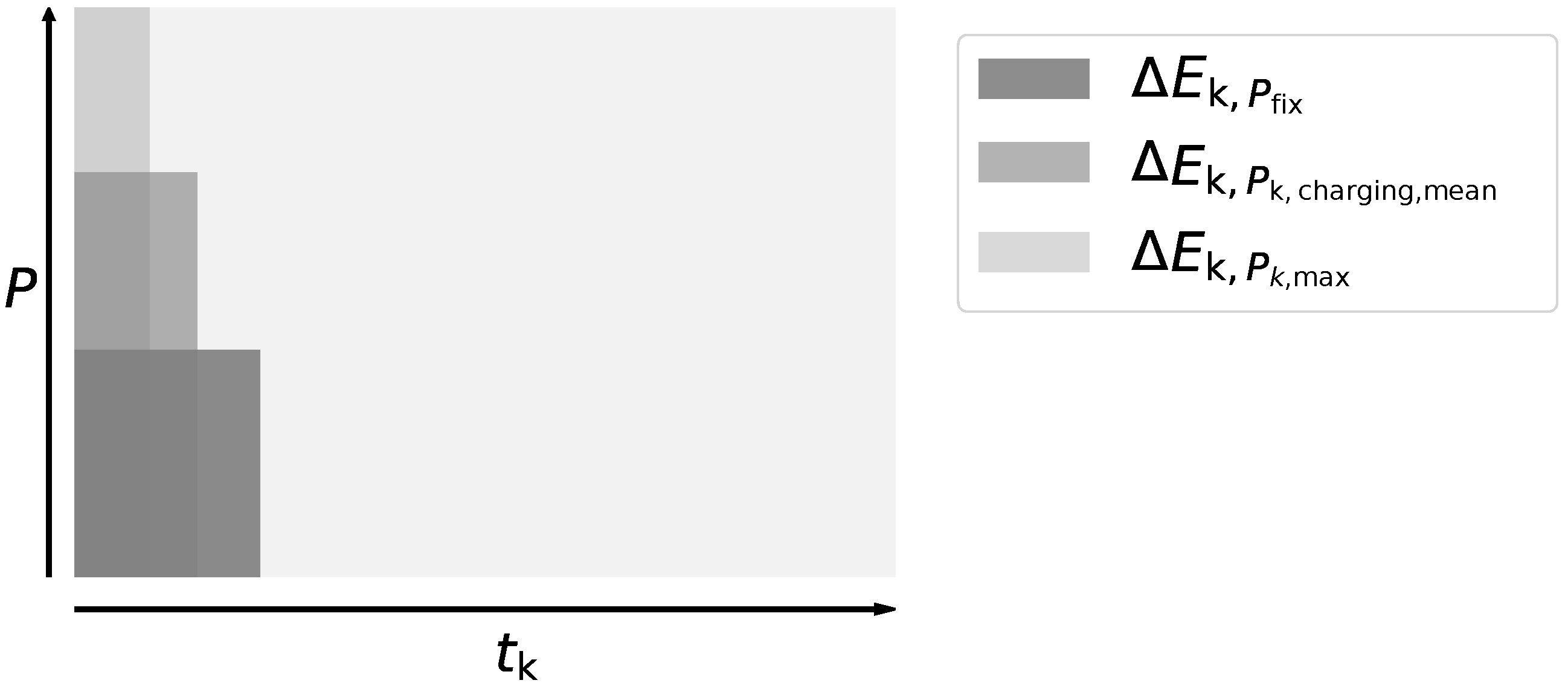
| Parameter | Meaning | Format/Unit |
|---|---|---|
| h | Index; indicates the h-th charging event of the charging point | - |
| k | Event-ID of the charging event; , where describes the set of charging events | - |
| plug_in time of charging event k | HH:MM:SS dd.mm.YYYY | |
| plug_out time of charging event k | HH:MM:SS dd.mm.YYYY | |
| Duration of the charging event k | HH:MM:SS | |
| Duration of the charging process of the charging event k | HH:MM:SS | |
| Maximum charging rate of the charging event k | ||
| Mean charge power of the charging event | ||
| Mean charge power of the charging process | ||
| Charged energy of the charging event k |
| Office Site | Logistics Site | Agency Site | |
|---|---|---|---|
| Time period | 09/2019–08/2020 | 01–02/2020 | 01–02/2020 |
| Number of charging points | 8 | 12 | 12 |
| Number of EVs | 15 | 12 | 12 |
| Total charged energy [] | 8179.22 | 5563.05 | 3151.23 |
| Number charging events | 509 | 268 | 374 |
| Average charged energy per event [] | 16.47 | 20.81 | 8.61 |
| Average charging power per event [] | 7.89 | 10.28 | 9.47 |
| Average plug_in duration per event | 09:29:00 | 22:02:24 | 14:30:09 |
| Average charging process duration per event | 02:30:04 | 03:23:12 | 01:20:12 |
| Office | Logistic | Agency | |
|---|---|---|---|
| Events | 400 | 260 | 273 |
| in | 3.68 | 3.68 | 3.68 |
| in h | 04:17:37 | 05:50:43 | 02:34:53 |
| in h | 2.29 | 4.14 | 4.47 |
| in | 7.69 | 6.54 | 6.57 |
| in h | 02:06:44 | 03:29:22 | 01:30:06 |
| in h | 4.35 | 7.33 | 6.8 |
| in | 10.08 | 7.18 | 9.29 |
| in h | 01:42:12 | 03:06:03 | 01:08:17 |
| in h | 6.21 | 8.22 | 11.24 |
Publisher’s Note: MDPI stays neutral with regard to jurisdictional claims in published maps and institutional affiliations. |
© 2021 by the authors. Licensee MDPI, Basel, Switzerland. This article is an open access article distributed under the terms and conditions of the Creative Commons Attribution (CC BY) license (https://creativecommons.org/licenses/by/4.0/).
Share and Cite
Barthel, V.; Schlund, J.; Landes, P.; Brandmeier, V.; Pruckner, M. Analyzing the Charging Flexibility Potential of Different Electric Vehicle Fleets Using Real-World Charging Data. Energies 2021, 14, 4961. https://doi.org/10.3390/en14164961
Barthel V, Schlund J, Landes P, Brandmeier V, Pruckner M. Analyzing the Charging Flexibility Potential of Different Electric Vehicle Fleets Using Real-World Charging Data. Energies. 2021; 14(16):4961. https://doi.org/10.3390/en14164961
Chicago/Turabian StyleBarthel, Vincent, Jonas Schlund, Philipp Landes, Veronika Brandmeier, and Marco Pruckner. 2021. "Analyzing the Charging Flexibility Potential of Different Electric Vehicle Fleets Using Real-World Charging Data" Energies 14, no. 16: 4961. https://doi.org/10.3390/en14164961
APA StyleBarthel, V., Schlund, J., Landes, P., Brandmeier, V., & Pruckner, M. (2021). Analyzing the Charging Flexibility Potential of Different Electric Vehicle Fleets Using Real-World Charging Data. Energies, 14(16), 4961. https://doi.org/10.3390/en14164961







